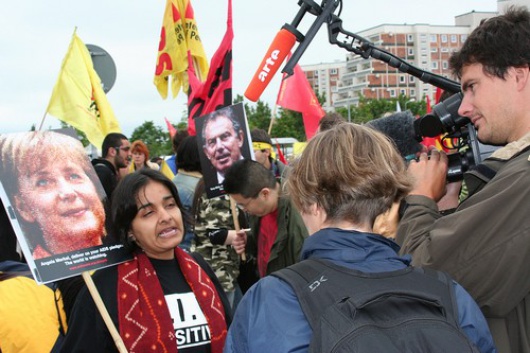Heiligen-damn
Published on
Translation by:
 claire mcbride
claire mcbride
A 12 million Euro security fence surrounds the small German seaside town, where the largest industrial nations in the world met on 6 and 7 June for the G8 summit
 100 Million Euros: this is the estimate for the cost of the two-day summit meeting of the world’s most influential heads of state. Even though the growing differences in opinion between Washington and Moscow and climate change are on the agenda for the G8 summit, the opposers of globalisation have still got something to say. After a turbulent weekend, which came to a head with arguments and violence between demonstrators and the authorities, the debate and discussion began with the opening of the Rostock alternative summit and the official start of the G8-summit in Heiligendamm at a diplomatic level.
100 Million Euros: this is the estimate for the cost of the two-day summit meeting of the world’s most influential heads of state. Even though the growing differences in opinion between Washington and Moscow and climate change are on the agenda for the G8 summit, the opposers of globalisation have still got something to say. After a turbulent weekend, which came to a head with arguments and violence between demonstrators and the authorities, the debate and discussion began with the opening of the Rostock alternative summit and the official start of the G8-summit in Heiligendamm at a diplomatic level.
Dominic Timms/ ActionAid
Regardless of the violent clashes by protesters last Sunday, despite Germany's biggest police and security contingent since World War Two, civil mobilisation seems to be more important than last years G8 summit in Saint Petersburg.
 On 5 June Jan Ziegler, the UN special rapporteur on the right to food, opened the alternative summit in Rostock with a stirring speech. He criticised the incapability of G8 members to fulfil their duties towards Africa, duties which were agreed upon at the summit in Gleneagles in Scotland in 2005.
On 5 June Jan Ziegler, the UN special rapporteur on the right to food, opened the alternative summit in Rostock with a stirring speech. He criticised the incapability of G8 members to fulfil their duties towards Africa, duties which were agreed upon at the summit in Gleneagles in Scotland in 2005.
Dominic Timms/ ActionAid
'I have come over from Africa to take part in alternative summits. Pressure needs to be put on heads of state to fulfil their promises and obligations,’ explains Collins Magalasi, who is taking part in the alternative talks on behalf of his aid organisation ActionAid for Malawi. ‘I’m deeply disturbed that the richer countries are not keeping their promises to Africa or about climate protection as the lives of millions of people hang in the balance,' he continues. 'Even now we find ourselves here on the coast, and I hope that those in charge will finally stop burying their heads in the sand.’
Translated from Heiligendam : un G8 sous haute pression


